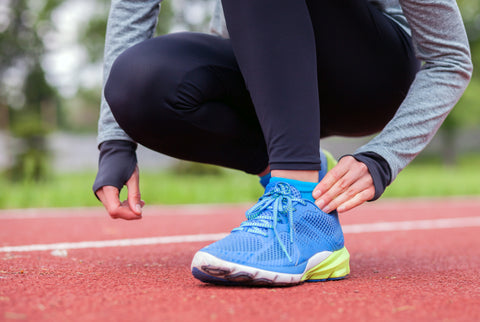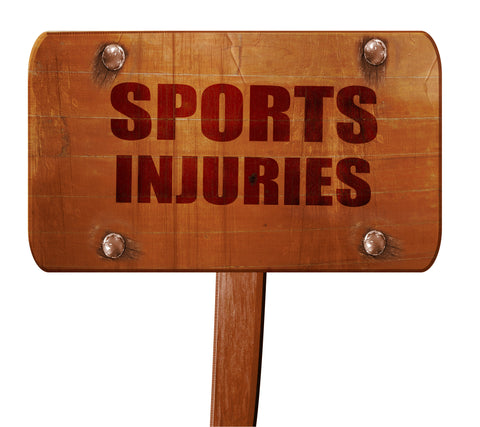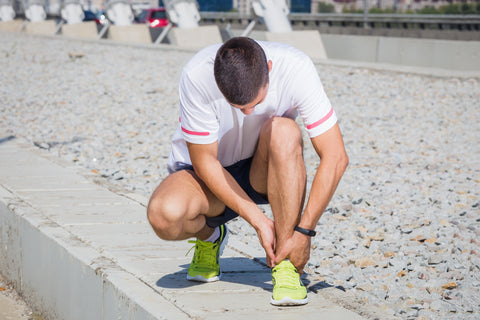Running Shoes and Injuries

Since the 2009 release of Christopher McDougal’s book Born to Run, the minimalist running movement has experienced a resurgence of popularity with a subsequent release of various minimalist running shoes. But what type of shoe is best? What injuries are associated with different types of running shoes? Read on to find out.
The primary difference between running in a minimalist shoe and running in a modern (post 1970) heel cushioned running shoe is what is referred to as the “heel to toe drop”. The higher the cushion on the heel, the greater the heel to toe drop. Many minimalist running shoe companies create their shoes deliberately with a low heel to toe drop values, creating a flatter sole with less foam overall. This shoe engineering is thought to encourage the forefoot (ball of the foot) or mid-foot first contact that is also observed in many elite runners. This running form has been shown to decrease forces through the feet and legs, and encourage a faster rate of leg turn-over for a faster stride.
A 2010 study by Daniel Leiberman out of Harvard University compared the amount of force transmitted through the body in runners while barefoot versus in a modern heel cushioned running shoe (the ASICS GEL-CUMULUS). Runners participating in the study included African runners whom had always run barefoot, runners who ran in Vibram minimalist shoes, and runners who ran in cushioned heel shoes. The research team studied the runners while barefoot and while wearing cushioned running shoes. Using a force plate implanted in the ground that measures the amount of force that the runner places into the ground, and then how much force is then exerted back up from the ground through the foot and legs gave accurate readings.
The results of this study demonstrate that runners who had been training in minimalist or barefoot conditions and who ran with a forefoot-first contact method experienced 3 times less force through their legs while running. In real life running, this means that runners have the potential to limit injuries such as stress fractures in the foot and legs, as well as plantar fasciitis and overuse injuries by running with better form and in a shoe that promotes good running form.

Does this mean that you should toss your cushioned running shoes into the garbage? If you are running in a cushioned shoe and are not getting injured, then radical changes in footwear are not necessary. If you are getting injured and recognize that you are contacting the ground heavily on your heel, you may consider practicing a shorter running stride and landing on the ball of your foot or the mid-foot. Drastic changes from a cushioned shoe to a barefoot running are not recommended, because this is when most injuries tend to occur. It is necessary to have strong hips and feet if you are considering using a minimalist shoe or running barefoot. If you are ready to make the switch, begin with shorter runs in the new shoes: 1-3 miles 1-2 times per week for 3-5 weeks before heading out for a longer run.
There are also many mid-range minimalist running shoes on the market. Brooks and New Balance both offer a lightweight running shoe for example, that has a small heel to toe drop value, yet offers a bit more support than a true barefoot model.
On the other end of the spectrum are “Maximalist shoes”. These are shoes with intentionally very thick foam support. The HokaOne is the most prominent maximalist shoe on the market with a weight of 12.3 oz for men and 10.5 oz, for women. This is considered a heavy shoe. The depth of the foam is drastic at 30mm in the heel and 24 mm in the forefoot in their “oversize” model, and a more dramatic 35mm heel and 31 mm forefoot in the “trail” edition.

A 2012 study out of the University of Colorado Boulder demonstrated that it is more physiologically efficient to run in shoes versus running barefoot, and that specifically lighter weight shoes allow for more efficient running. The investigators found that for every 100g of weight added to the foot, the volume of oxygen consumed (VO2 max) increased by 1%.
It is important to consider the challenges to interpreting results of laboratory studies on running shoes. First and foremost, most of these studies are conducted on treadmills, which does not account for terrain changes. Estimates can be made regarding energy expenditure on the ground versus treadmill running. Secondly, many studies are performed on elite runners with similar running styles. This does not allow for complete translation to novice or mid-level runners with varying running styles.
If you have questions about your running form, physical therapists specializing in running injuries are a great resource. Many of them will conduct a video analysis of your running form and make specific recommendations for improved performance and decreased injury while running and can help you select a shoe for your body and running needs.
Whatever shoe you decide to use, it will help you enjoy the road, trail or track as much as possible.
Leave a comment
Comments will be approved before showing up.


